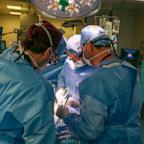Vein Removal Method Linked to Bypass Results
July 16 -- WEDNESDAY, July 15 (HealthDay News) -- A study originally designed for a completely different purpose has unearthed a disturbing finding about coronary artery bypass surgery: The way that the vein used for the bypass is removed from the body appears to affect the long-term outcome of the surgery.
People whose veins are removed by the minimally invasive technique called endoscopic harvesting had higher rates of bypass failure, heart attacks and death, according to a report in the July 16 issue of the New England Journal of Medicine.
The finding was entirely unexpected, said study senior author Dr. John H. Alexander, a cardiologist at Duke Clinical Research Institute. The study of 3,000 people who had bypass surgery was designed to determine whether treating the removed veins with a drug would improve results. (It didn't.) Only longer-term analysis of the study data revealed the difference in outcome between veins obtained by endoscopic harvesting and those obtained through conventional surgery.
"The mortality difference did not become apparent for at least nine or 10 months," Alexander said. "No one would have thought you needed a year or more to detect a difference in outcome."
Endoscopic harvesting, which uses a one- or two-inch incision to remove a saphenous vein from a leg, is used in 70 percent of the 450,000 coronary bypass operations done annually in the United States. Conventional surgery, which requires a much longer incision, is used in the other 30 percent of cases. Endoscopic harvesting is popular among surgeons and people having bypasses because it virtually eliminates the risk of infection, excess bleeding and other complications associated with conventional removal.
The journal report does not discuss those advantages. Instead, it focuses on the greater rate of graft failure (46.7 percent versus 38 percent at 18 months), death or heart attack (9.3 percent versus 7.6 percent at three years) and deaths (7.4 percent versus 5.8 percent at three years) seen in those who had endoscopic harvesting.




